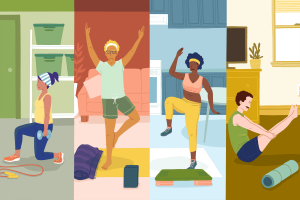As we all know, exercise plays a pivotal role in optimising our physical and mental health. No matter your age, having an active lifestyle is crucial, as it helps provide routine to our life. However, because of work or family commitments, not all of us can fit time in our day to go to the gym or it’s simply not a place everyone feels comfortable going to for exercise. Because of this, people find it difficult to integrate exercise into their life, especially at home – where we don’t have all the equipment such as cable machines, bands, balls, dumbbells etc. For those who want to start an exercise routine but struggle to do so without equipment, here are some tips on how it can be done – depending on your goals.
Strength: If your aim to is build muscle mass or strength- a variety of upper body and lower body exercises can be done with just body weight. If you do want to add some more resistance- simply fill up water bottles, milk bottles or use cans of soup. Even using something such as bag or a suitcase can work, anything that provides a resistance will do the trick. For lower body you can do body weight squats, lunges, glute bridges, sit to stands, calf raises, standing leg curls etc. If you are looking to build upper body strength you can do push ups (either against a wall, kitchen bench or floor), a curl and press, lateral raises, or an overhead press. If you need to build abdominal/core strength you can complete a plank, shoulder taps, crunches on the floor or double leg raises (lying on your back, raising both of your legs). Depending on what you want to work on, select any of these exercises, and do 2-3 sets of these, completing 10-12 repetitions of each.
Aerobic Training: If you are looking to build overall endurance and cardiovascular fitness, there are variety of ways you can achieve this at home. Typically, those that are higher in intensity and are longer in duration. For example, you can do star jumps, mountain climbers (or plank knee drives on a bench), standing marches, air boxing (or boxing with water bottles) or burpees. You can either do 20-40 repetitions or set a timer for each. Another way of challenging endurance can be to do a circuit-based workout. This can be done by selecting a handful of exercises (roughly five or six) and completing those in a circuit for a duration of time or three to four sets. This way might be more achievable as we can modify the intensity and can be done at a slower pace – whilst still getting endurance benefits.
Balance: If you are looking to reduce falls risk, there are a variety of ways to improve balance. To challenge balance or proprioception, it can be done by reducing base of support or standing on an unstable surface. This can be done via a heel to toe walk, simply standing in a heel to toe stance or even standing on one leg. This is all done with body weight, but you can use objects such as a pillow to provide an unstable surface.
These exercises mentioned above are some of many that you can do at home- but if you are just getting started, it’s important to keep it simple. If time is a barrier, these exercises can be done in five-to-ten-minute blocks, even doing three or four exercises at a time is beneficial. Doing any exercise, even if its for a short amount of time, is better than doing nothing at all. Once we build a routine, we can do more during the day and eventually, this will accumulate to roughly 150 minutes per week (which is the minimal recommended amount according to Australian Physical Activity Guidelines).




